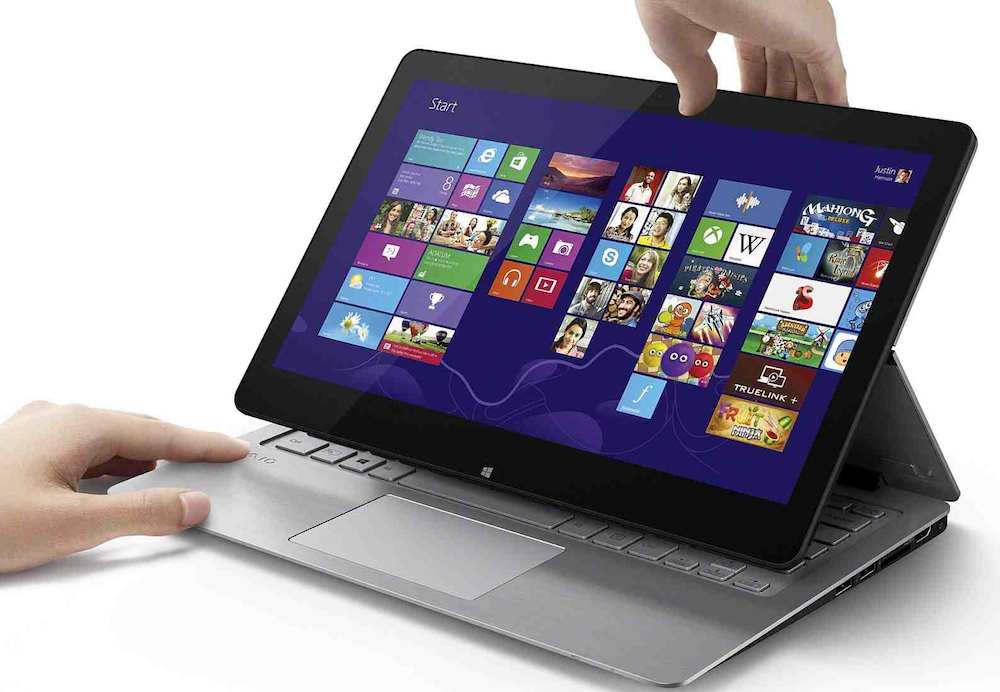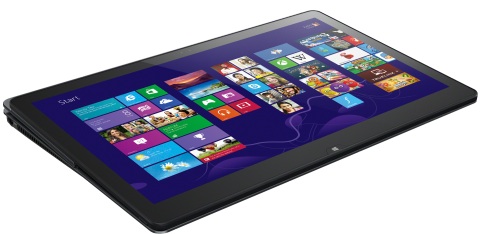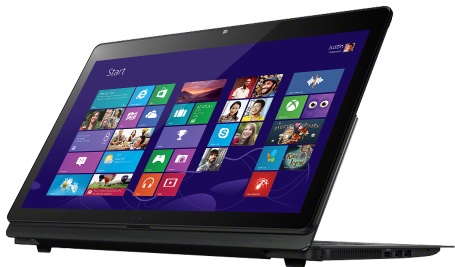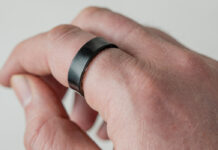
Sony’s Vaio series of PC laptops has always won points for style and design and the company has become a leader in producing Windows 8 hybrid machines —portables that combine Windows 8 PC and tablet capabilities. When I was offered the opportunity to spend time with the new Vaio Fit 15A Multi Flip PC, I was pretty excited. This latest model has been generating buzz since being featured on Microsoft’s Windows website and I’ve been looking forward to trying out Sony’s latest take on the hybrid form factor. After spending a week putting it through its paces, I can assure you that the Vaio Fit 15A is one of the most useful variations yet on the tablet/notebook convertible hybrid, a real looker (especially in the black finish of the test unit) and an able performer. It’s held back a little by a few details —a loud and persistent fan, so-so keyboard, and not so stellar battery life among them— but offers a solid portable computer experience, along with tablet capability in a single package that just happens to look pretty smashing.
Flip or Fit?
One thing to get out of the way before we get any deeper into the review is the name of this thing. Sony may have confused a few people last fall through pre-release promotion of its Flip PC line, yet this laptop bears the name: Vaio Fit 15A. There are reviews online for a Vaio Flip 15, so which is it? The answer is, they are one and the same. Sony introduced a line of products it’s calling Flip PCs. Among that line of Flip PCs is the Vaio Fit 15A —or to use its full, official designation, the Vaio Fit 15A Multi Flip PC.
 Tablet Capability
Tablet Capability
The reason behind that Flip PC designation may not be obvious at first glance, other than a horizontal line running the width of the laptop’s outer lid. This line marks the location of a pivoting hinge. Under normal (laptop) mode, you pop open the lid, tilt it back and away you go. Decide that you want to use the Vaio Fit 15A as a 15-inch Windows 8 tablet instead and you simply release a latch at the base of the display and the entire screen will pivot along that line.
Let it pivot all the way back and it secures magnetically. You then close the lid (covering the keyboard) and you have a very serviceable tablet. It’s a heavy tablet and one side is slightly thicker than the other, but it does the job quite nicely. Or, you could leave the top open with the display now facing out, using the Vaio Fit 15A as a presentation or display device that offers an adjustable viewing angle, secure base and keeps the keyboard out of sight.
Just how easy is it to make the transformations? I shot a quick video showing the process.
Highlights
As mentioned in the opener and alluded to in the title, this is a very attractive looking laptop. Sony used brushed aluminum on many of the surfaces, some of which are only millimetres thick and the effect is a very premium look. I think the black finish makes it even better, although you do then have to pay the price of fingerprints…
Sony’s been really hitting it out of the ballpark lately with its mobile displays and the Vaio Fit 15A is no exception. My loaner had only a Full HD (1920 x 1080) display —Sony makes one of these with a 2880 x 1620 screen— but it looks great. The company has incorporated its proprietary Triluminos for Mobile technology and it’s driven by a Nvidia GeForce GT735M graphics card. The display was crisp, bright, had good viewing angles and as a touchscreen it was extremely responsive. I can only imagine how sharp that WQHD version must be, but I can’t imagine anyone being disappointed with the Full HD version.
The rest of the Vaio Fit 15A’s hardware was also chosen with performance in mind. Inside, a 4th generation Intel Core i7 processor provides the power, with 12GB or RAM to chew on. Storage is a hybrid drive (1 TB hard disk combined with 16GB NAND Flash) that offers rapid startup with plenty of disk space for big multimedia files.
Specifications
|

About Those Flaws
I mentioned a few flaws or details that Sony didn’t quite nail with the rest of the design. There are a few tradeoffs to be aware of with such a sleek, powerful machine and its Transformer-like capabilities.
First up is battery life. It’s not uncommon these days to see Ultrabooks and portables equipped with Haswell chips clocking 10 hours or more of battery life. But between that big, 15-inch display and the Core i7 CPU (opposed to a less hungry Core i5 or Core i3), the Vaio Fit 15A is rated at only 5 hours of battery life. Based on my time with it, that’s about right —maybe even a little generous.
Second is the fan. This is one of the louder fans I’ve heard in recent memory and it was on a lot. At times, it was audible over the sound of the furnace running from across the room even while web browsing. Switching to “Power Saver” mode helped, but that does come at a performance hit.
Finally, the keyboard. As someone who writes for a living, keyboards are important to me. The Vaio Fit 15A’s was not my favourite. The keys don’t have as much travel as I’d like and the keyboard flexes a bit toward the middle. The keys are backlit —which is great— but several clusters on the tester (mostly punctuation keys) weren’t working. This is most likely a result of the test model being shipped around, but I can’t help but wonder if maybe the flexibility of the keyboard might have had something to do with it.
I’m the kind of person who spends hours at a time working at a computer, so I may well be more sensitive to fan noise and keyboard performance than the average person, so file those under the “may or may not be relevant to you” category. You can certainly pop into a local Best Buy store to play with a Vaio Fit 15A and see if you even notice…

Should I Buy It?
Minor quibbles aside, the Sony Vaio Fit 15A is a very nice laptop PC. If you’re looking for a portable PC that has the specs needed to run your Windows software without blinking, this would be a good choice —so long as you don’t plan to be using it away from a power outlet for the entire day.
For serious video gaming on the go, you’re still going to want a specialized gaming laptop. But for occasional games, the Nvidia video card and dedicated VRAM means the Vaio Fit 15A is going to do better than most Ultrabooks and laptops that rely on integrated graphics. It goes without saying that the big, Sony Triluminos display in Full HD is great for watching movies.
And if you want to have the option of using Windows 8 in tablet mode —without shelling out the extra for a Windows 8 tablet— then the Sony Vaio Fit 15A is one of your better choices.
And it doesn’t hurt that this 15-inch convertible laptop does it all while looking sleek, stylish and very much on the premium end of the scale.



